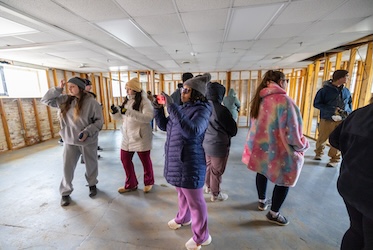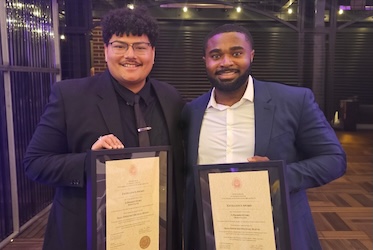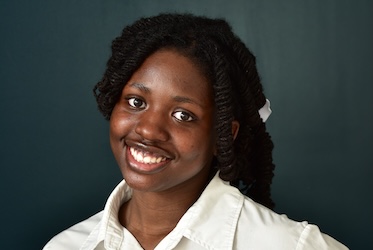
Furniture of the Future
MARIETTA, Ga. | Nov 7, 2018
Architecture students use skills to improve urban environments
In architecture, a building doesn’t have to be just four walls and a roof. Similarly, a chair doesn’t have to be four columns and a slab.
At Kennesaw State University, architecture students are challenging what constitutes an urban space by creating outdoor furniture that is interactive and playful instead of drab and utilitarian. This fall, students taking the Tactical Urbanism course offered by the Department of Architecture were tasked with creating a series of so-called “urban chairs.” The chairs were designed and built by the students with the intent that they can be configured in multiple ways in order to make public spaces more appealing.
The furniture, dubbed the Morphogenesis Chairs by students, includes six chairs made of birch plywood slats carefully cut on a Computer Numeric Control (CNC) machine and painted red and blue. Unlike the benches currently used along sidewalks in major cities across the county, the “urban chairs” designed by Kennesaw State students are crafted with portability and usability in mind.
In September, Zamila Karimi, a lecturer within the College of Architecture and Construction Management, and her students took their design to Atlanta’s Lenox Mall for PARK(ing) Day, an annual global event in which car parking spaces are temporarily transformed into miniature public parks. At the event, students told passersby to use the furniture however they see fit. Some used it as a reclining beach chair and others saw it as a bench. Children saw it as a piece of playground equipment while adults sometimes saw them as flower planters.

“As an architecture student, there aren’t many opportunities that allow us to engage directly with the public, so I found this to be a great opportunity to become involved,” said Steven Yang. “It’s incredible to see how creative people can be with the furniture we create. Typically, when you’re walking through a public space, you can touch the furniture and see it but rarely do you have a chance to play with it.”
Yang, along with fellow classmate Christine Vu, presented the original concept in class.
“With this design, we wanted it to have the ability to transform but still create something fun and playful,” said Vu.
Throughout the Tactical Urbanism course, students are exposed to the problems urban environments are facing, such as low interpersonal interaction, and are encouraged to use their architectural skills to find creative, low-cost solutions to improve the quality of public spaces. Karimi, said the approach is particularly impactful for KSU students because it provides a channel through which they can apply their studies.
The course begins by splitting the students into two groups to brainstorm ways to execute a design that fits the criteria given by Karimi. During the design development phase, models are developed at various scales to explore different aspects, such as assembly and portability. Once a fabrication strategy is agreed upon and a prototype has been tested, the class is ready to start with fabrication.

“This has direct relevance to the students as it offers an opportunity to put their skills into practice by designing small-scale architectural assemblages, fabricating them and ultimately testing them in the public sphere,” Karimi said. “On a more philosophical level, it exposes them to the responsibility we as architects have as social agents of change within our urban environments.”
Following the positive feedback at PARK(ing) Day, Karimi said her students will look for ways to introduce their temporary structures across the Kennesaw and Marietta campuses in the future, as well as seek opportunities to create permanent public structures across metro Atlanta.
“The main takeaway for my students is, they shouldn’t just think of themselves as service providers for their clients but to see that they have a real role to play in their neighborhoods, campuses and cities,” she said. “They have the power to bring people together with what they build and design. In the end, it becomes a playscape for all.”

– Travis Highfield
Photos and video by Rob Witzel
Related Stories

Kennesaw State architecture, engineering students reimagine Asheville's devastated River Arts District

Kennesaw State architecture students win silver in International Design Awards for reimagining of Marietta Square

Kennesaw State student receives award from National Association of Home Builders

Kennesaw State student integrates artificial intelligence into architectural design education
A leader in innovative teaching and learning, Kennesaw State University offers undergraduate, graduate, and doctoral degrees to its more than 47,000 students. Kennesaw State is a member of the University System of Georgia with 11 academic colleges. The university’s vibrant campus culture, diverse population, strong global ties, and entrepreneurial spirit draw students from throughout the country and the world. Kennesaw State is a Carnegie-designated doctoral research institution (R2), placing it among an elite group of only 8 percent of U.S. colleges and universities with an R1 or R2 status. For more information, visit kennesaw.edu.














